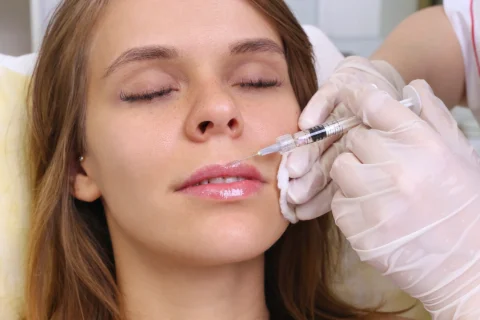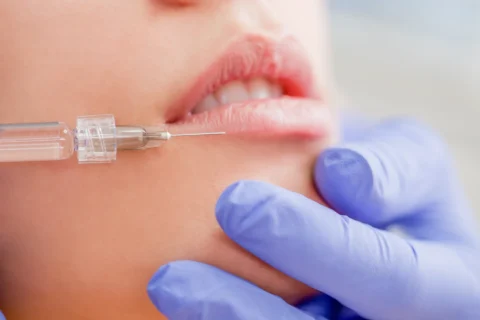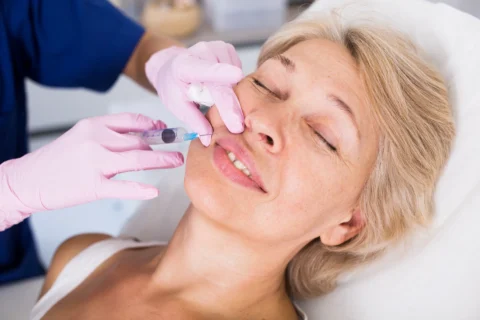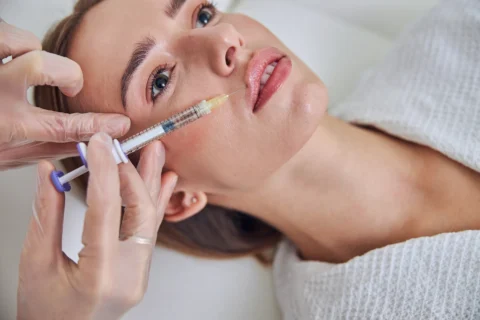Dermal filler injection treatments are becoming increasingly popular because of their minimally invasive treatment procedure and effective anti-wrinkle effect. But dermal fillers weren’t always as minimally invasive as it is today because of the needles used for each syringe of an injectable filler. From a sharp hypodermic needle to a blunt tip cannula (i.e, microcannula), its minimally invasive quality went through a long period of development.
So why are cannulae preferred over other dermal filler needles? Microcannula are blunt-tipped cylinders that are used as a substitute for a sharp tip needle to create a single point of entry even for larger treatment areas. Other than this, the cannula technique is also preferred because of the likelihood of avoiding the incident of injecting into a blood vessel when using blunt-tip cannula.
Why Use Cannula for Dermal Fillers?
Microcannula are blunt-tipped needles that are used to inject dermal fillers underneath the skin surface. These are used as a substitute for a sharp needle in facial filler injections (i.e, lip filler) to enhance facial treatment areas. In addition, cannulas are FDA-approved for use in the jowls, cheeks, and lips.
The use of a cannula depends on the aesthetic injector facilitating the treatment session. However, most med spa and plastic surgeon chooses to use microcannula because of the following reasons:
- A higher degree of precision
- A single entry point for penetration
- Lesser likelihood of intravascular injection
- Greater scope of the treatment area
- Minimized downtime and recovery period
- Minimal pain experienced
- Dermal filler injection flexibility
- Minimal skin injuries and complications inflicted (e.g, vascular occlusion, intravascular occlusion)
How Aesthetic Professionals Choose Cannula Size For Dermal Fillers
The length and size of a microcannula depend on the treatment area (e.g, double chin), facial anatomy, and the consistency of the dermal filler gel. Aside from the length and size of the microcannulas, the shape also matters in delivering the expected results.
These factors in choosing the right cannula are done considering the intended injection trajectory of the dermal filler syringe. The plastic surgeon who will be facilitating the entire treatment procedure is responsible for choosing the size of the cannula to be used in the dermal filler treatment. The range of recommended sizes usually falls among the following:
- 14 gauge cannula
- 22 gauge cannula
- 25 gauge cannula
- 27 gauge cannula
The kind of dermal filler used may also be a factor considered in the size of the cannula for dermal fillers. For instance, a hyaluronic acid filler (e.g, Juvederm ultra) may require a different size of cannula and injection technique for wrinkle areas and acne scars. Consequently, a hyaluronic acid filler injection cannula may also differ from other kinds of filler injectables.
In addition, hyaluronic acid filler injections are the kind of facial filler injection that uses a blunt-tipped cannula. So if you prefer to have your plastic surgeon use a cannula during your facial filler treatment session, it’s best to choose hyaluronic acid filler treatments.
Proper Usage Of Cannula: Cannula Technique For Dermal Fillers
Cannula is less likely to cause skin injuries and adverse effects, but its effectiveness and efficacy still largely depend on its proper usage. Below is the microcannula technique for dermal filler injection to maximize its safety and effectiveness:
- Avoid applying too much force
- Take note of the dermal filler rheology
- Pay attention to cannula feedback
Although cannulas are less likely to result in blood vessel punctuation, applying too much force can still cause this adverse effect. It helps to seek the services of an expert aesthetic provider who is well-equipped with knowledge and skills to work around the proper location and injection direction of the dermal filler syringe.
It’s also essential to determine the rheology of the dermal filler contained in the syringe. The dermal filler viscosity must be matched with the method of injecting the dermal fillers into the skin. If not, then the overall purpose of using microcannula wouldn’t be maximized.
Cannula may be more comfortable for patients, but there are instances when a vasovagal reaction may be triggered. Vasovagal reaction is when an individual faints as a result of unusual sensations, which in this case is caused by the cannula. So it’s essential to pay attention to how a patient feels while the cannula is being injected. It would also be helpful to inform them beforehand regarding what to expect during the dermal filler injection procedure.
Blunt Cannula Versus Needle for Dermal Fillers: What’s the Difference?
While a sharp needle is theoretically more precise, the way that a cannula is positioned confined the injectable filler into the desired trajectory of injection. Cannulae are also more precise than sharp needles because they are able to apply the injectable filler into the skin surface intended for dermal filler injection instead of into the blood vessels.
Additionally, in a study that evaluates the difference between a microcannula and a traditional needle, it was reported that patient satisfaction is actually 12% greater when using a cannula than a sharp needle. This may be because a microcannula decreases the time it takes to complete a treatment session while increasing the volume of dermal fillers applied to an injection site.
There are instances when a plastic surgeon uses a combination of needle and microcannula to deliver optimal results from the treatment. Combining a sharp-tipped needle and a blunt-tipped cannula would ensure the balance of effectiveness and safety by reducing skin injury using a cannula and enhancing precise filler injection using needles.
Despite the differences between needle injection and cannula, effective results still depend on the skill and expertise of the aesthetic injector. Although it provides a better feel of the structures beneath the skin, Cannulae may be safer but it’s more difficult to administer treatments using that than needles so the quality of results may be compromised.
This means that whether a blunt-tipped cannula or a sharp needle is used, looking for an expert aesthetic provider should still be the top priority. Each device may only be effective to eliminate wrinkles and correcting skin laxity when the treatments that these are used for are carried out by the right hands.
How Blunt Cannula For Dermal Fillers Minimizes Risks and Side Effects
The longer length of cannulas also reduces the likelihood of risks and side effects that can be experienced by a patient when they undergo dermal filler treatments. First, cannulas reduce the pain that may be experienced by the patient during and after the procedure because of its blunt tip and the fewer injection points that cannulas require for the dermal filler to take effect.
Next, a blunt-tipped cannula merely displaces blood vessels instead of lacerating them. This decreases the likelihood of bruising, pain, swelling, and other adverse effects that may occur when a needle punctures a blood vessel. Although the side effects mentioned may still occur, their presence would be minimal compared to the extent of skin injuries that would occur when needles are used.
Best Dermal Filler Cannula Injection Technique at Ethos Spa
While a cannula is preferred over a needle, both of these 2 injection options deliver the same aesthetic outcomes in eliminating wrinkles and improving skin condition. What’s crucial to ensure that the cosmetic injections would work as intended is the skill and the expertise of the aesthetic provider or the med spa who will be performing the dermal filler treatment procedure.
Ethos Spa offers state-of-the-art aesthetic treatments conducted by board-certified aesthetic providers who are highly trained and experienced and will create a customized treatment plan to meet your needs. Aside from plastic surgery alternatives such as body sculpting and dermal fillers, Ethos Aesthetics + Wellness offers PRP hair loss treatments, laser skin resurfacing, body contouring procedures, and facial filler (i.e, lip filler) treatment.
Contact us to learn more about our non-invasive treatment options here at Ethos Spa.







